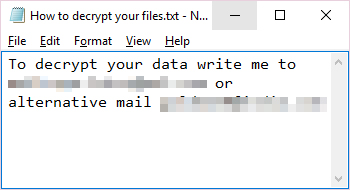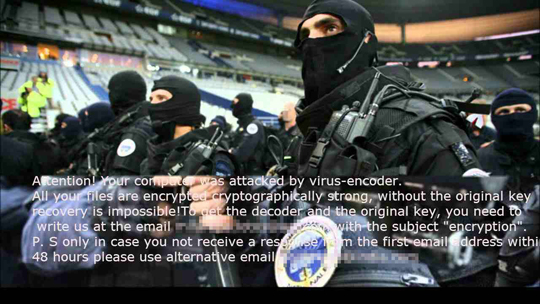RANSOM_CRYSIS.A
Ransom:Win32/Tescrypt!rfn (Microsoft), Trojan-Ransom.Win32.Crusis.f (Kaspersky), Trojan.Randsom.A (Symantec), a variant of Win32/Filecoder.Crysis.D (ESET)
Windows


Threat Type: Trojan
Destructiveness: No
Encrypted:
In the wild: Yes
OVERVIEW
Downloaded from the Internet
This Trojan arrives on a system as a file dropped by other malware or as a file downloaded unknowingly by users when visiting malicious sites.
TECHNICAL DETAILS
271,149 bytes
EXE
Yes
05 Jul 2016
Connects to URLs/IPs, Encrypts files, Displays message/message boxes, Displays graphics/image
Arrival Details
This Trojan arrives on a system as a file dropped by other malware or as a file downloaded unknowingly by users when visiting malicious sites.
Installation
This Trojan drops the following files:
- %User Startup%\How to decrypt your files.jpg – image used as wallpaper
- %User Startup%\How to decrypt your files.txt – ransom note
- %Desktop%\How to decrypt your files.txt – ransom note
- %User Profile%\How to decrypt your files.jpg – ransom note
(Note: %User Startup% is the current user's Startup folder, which is usually C:\Documents and Settings\{user}\Start Menu\Programs\Startup on Windows 2000 and XP, and C:\Documents and Settings\{User name}\Start Menu\Programs\Startup on Windows Vista, 7, and 8.. %Desktop% is the desktop folder, where it usually is C:\Documents and Settings\{user name}\Desktop in Windows 2000, Windows Server 2003, and Windows XP (32- and 64-bit); C:\Users\{user name}\Desktop in Windows Vista (32- and 64-bit), Windows 7 (32- and 64-bit), Windows 8 (32- and 64-bit), Windows 8.1 (32- and 64-bit), Windows Server 2008, and Windows Server 2012.. %User Profile% is the current user's profile folder, which is usually C:\Documents and Settings\{user name} on Windows 2000, XP, and Server 2003, or C:\Users\{user name} on Windows Vista and 7.)
It drops the following copies of itself into the affected system:
- %Application Data%\{malware filename}.exe
- %System%\{malware filename}.exe
- %User Startup%\{malware filename}.exe
(Note: %Application Data% is the Application Data folder, where it usually is C:\Documents and Settings\{user name}\Application Data on Windows 2000, Windows Server 2003, and Windows XP (32- and 64-bit); C:\Users\{user name}\AppData\Roaming on Windows Vista (32- and 64-bit), Windows 7 (32- and 64-bit), Windows 8 (32- and 64-bit), Windows 8.1 (32- and 64-bit), Windows Server 2008, and Windows Server 2012.. %System% is the Windows system folder, where it usually is C:\Windows\System32 on all Windows operating system versions.. %User Startup% is the current user's Startup folder, which is usually C:\Documents and Settings\{user}\Start Menu\Programs\Startup on Windows 2000 and XP, and C:\Documents and Settings\{User name}\Start Menu\Programs\Startup on Windows Vista, 7, and 8.)
Autostart Technique
This Trojan adds the following registry entries to enable its automatic execution at every system startup:
HKEY_LOCAL_MACHINE\Software\Microsoft\
Windows\CurrentVersion\Run
{random 8 characters} = "%System%\{malware filename}.exe"
HKEY_CURRENT_USER\Software\Microsoft\
Windows\CurrentVersion\Run
{random 8 characters} = "%System%\{malware filename}.exe"
Other System Modifications
This Trojan modifies the following file(s):
- It encrypts files in all fixed, remote and removable drives.
- It appends the extension .id-{victim ID}.{mailrepa.lotos@aol.com}.CrySiS to the encrypted files.
(Note: Other variants append .id-{victim ID}.{email address}.xtbl or .id-{victim ID}.{email address}.cbf)
It changes the desktop wallpaper by modifying the following registry entries:
HKEY_CURRENT_USER\Control Panel\Desktop
Wallpaper = "%User Profile%\How to decrypt your files.jpg"
(Note: The default value data of the said registry entry is {user-defined}.)
It sets the system's desktop wallpaper to the following image:
Other Details
This Trojan encrypts files with the following extensions:
- .odc
- .odm
- .odp
- .ods
- .odt
- .docm
- .docx
- .doc
- .odb
- .mp4
- sql
- .7z
- .m4a
- .rar
- .wma
- .gdb
- .tax
- .pkpass
- .bc6
- .bc7
- .avi
- .wmv
- .csv
- .d3dbsp
- .zip
- .sie
- .sum
- .ibank
- .t13
- .t12
- .qdf
- .bkp
- .qic
- .bkf
- .sidn
- .sidd
- .mddata
- .itl
- .itdb
- .icxs
- .hvpl
- .hplg
- .hkdb
- .mdbackup
- .syncdb
- .gho
- .cas
- .svg
- .map
- .wmo
- .itm
- .sb
- .fos
- .mov
- .vdf
- .ztmp
- .sis
- .sid
- .ncf
- .menu
- .layout
- .dmp
- .blob
- .esm
- .vcf
- .vtf
- .dazip
- .fpk
- .mlx
- .kf
- .iwd
- .vpk
- .tor
- .psk
- .rim
- .w3x
- .fsh
- .ntl
- .arch00
- .lvl
- .snx
- .cfr
- .ff
- .vpp_pc
- .lrf
- .m2
- .mcmeta
- .vfs0
- .mpqge
- .kdb
- .db0
- .dba
- .rofl
- .hkx
- .bar
- .upk
- .das
- .iwi
- .litemod
- .asset
- .forge
- .ltx
- .bsa
- .apk
- .re4
- .sav
- .lbf
- .slm
- .bik
- .epk
- .rgss3a
- .pak
- .big
- wallet
- .wotreplay
- .xxx
- .desc
- .py
- .m3u
- .flv
- .js
- .css
- .rb
- .png
- .jpeg
- .txt
- .p7c
- .p7b
- .p12
- .pfx
- .pem
- .crt
- .cer
- .der
- .x3f
- .srw
- .pef
- .ptx
- .r3d
- .rw2
- .rwl
- .raw
- .raf
- .orf
- .nrw
- .mrwref
- .mef
- .erf
- .kdc
- .dcr
- .cr2
- .crw
- .bay
- .sr2
- .srf
- .arw
- .3fr
- .dng
- .jpe
- .jpg
- .cdr
- .indd
- .ai
- .eps
- .pdd
- .psd
- .dbf
- .mdf
- .wb2
- .rtf
- .wpd
- .dxg
- .xf
- .dwg
- .pst
- .accdb
- .mdb
- .pptm
- .pptx
- .ppt
- .xlk
- .xlsb
- .xlsm
- .xlsx
- .xls
- .wps
It does the following:
- It connects to the following sites:
- http://{BLOCKED}ika234.cc/crs/pass/index.php
- http://{BLOCKED}ika234.cc/crs/stat/index.php
- It sends the following formatted information to the aforementioned sites:
- submit=submit&id={ID} &guid={guid} &pc={computername} &mail={ransom contact email}
- It deletes shadow copies by executing the following command:
- vssadmin delete shadows /all /quiet
- It avoids encrypting files/directories with the following strings:
- %windir%
- boot.ini
- bootfont.bin
- ntldr
- ntdetect.com
- io.sys
- explorer.exe
- svchost.exe
NOTES:
The dropped ransom note How to decrypt your files.txt contains the following message:

SOLUTION
9.800
Step 1
Before doing any scans, Windows XP, Windows Vista, and Windows 7 users must disable System Restore to allow full scanning of their computers.
Step 2
Note that not all files, folders, and registry keys and entries are installed on your computer during this malware's/spyware's/grayware's execution. This may be due to incomplete installation or other operating system conditions. If you do not find the same files/folders/registry information, please proceed to the next step.
Step 3
Scan your computer with your Trend Micro product and note files detected as RANSOM_CRYSIS.A
Step 4
Restart in Safe Mode
Step 5
Delete this registry value
Important: Editing the Windows Registry incorrectly can lead to irreversible system malfunction. Please do this step only if you know how or you can ask assistance from your system administrator. Else, check this Microsoft article first before modifying your computer's registry.
- In HKEY_LOCAL_MACHINE\Software\Microsoft\Windows\CurrentVersion\Run
- {random 8 characters} = "%System%\{malware filename}.exe"
- {random 8 characters} = "%System%\{malware filename}.exe"
- In HKEY_CURRENT_USER\Software\Microsoft\Windows\CurrentVersion\Run
- {random 8 characters} = "%System%\{malware filename}.exe"
- {random 8 characters} = "%System%\{malware filename}.exe"
Step 6
Search and delete this file
- %User Startup%\How to decrypt your files.jpg
- %User Startup%\How to decrypt your files.txt
- %Desktop%\How to decrypt your files.txt
- %User Profile%\How to decrypt your files.jpg
Step 7
Restart in normal mode and scan your computer with your Trend Micro product for files detected as RANSOM_CRYSIS.A. If the detected files have already been cleaned, deleted, or quarantined by your Trend Micro product, no further step is required. You may opt to simply delete the quarantined files. Please check this Knowledge Base page for more information.
Step 8
Reset your Desktop properties
Step 9
Restore encrypted files from backup.
Did this description help? Tell us how we did.


